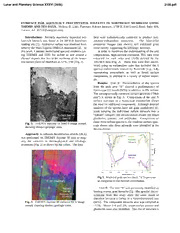
Evidence for Aqueously Precipitated Sulfates in Northeast Meridiani Using THEMIS and TES Data PDF
Preview Evidence for Aqueously Precipitated Sulfates in Northeast Meridiani Using THEMIS and TES Data
Lunar and Planetary Science XXXVI (2005) 2180.pdf EVIDENCE FOR AQUEOUSLY PRECIPITATED SULFATES IN NORTHEAST MERIDIANI USING THEMIS AND TES DATA. Melissa D. Lane, Planetary Science Institute, 1700 E. Fort Lowell Road, Suite 106, Tucson, AZ 85719 ([email protected]). Introduction: Recently aqueously deposited sul- then were radiometrically corrected to produce tem- fate-rich bedrock was found at the MER-B Meridiani perature-independent emissivity. The false-color landing site [1]. Additional sulfate was observed from emissivity images (not shown) still exhibited great orbit by the Mars Express OMEGA instrument [2]. In color variety, supporting the lithologic diversity. this work, I present midinfrared spectral evidence (us- In order to maximize the understanding of the unit ing THEMIS and TES) for sulfate in and around a compositions, high-spectral-resolution TES data were channel deposit that lies to the northeast of the hema- extracted for each color unit (A-D) defined by the tite-strewn plains of Meridiani at ~2ºN, 1ºW (Fig. 1). THEMIS data (Fig. 2). These data were then decon- voled using an endmember suite that included the 8 spectral endmembers derived by Bandfield [e.g., 3,4], representing atmospheric as well as broad surface components, in addition to a variety of sulfate miner- als. Results: Unit A: Deconvolution of the spectra from the pink area “A” showed a predominance of Syrtis-type [3] basalt (92%) in addition to 8% sulfate. The atmospherically corrected surface spectrum (“Pink unit”) is shown in Fig. 3. Comparison of the unit A surface spectrum to a Syrtis-type endmember shows the need for additional components. Although detailed analyses of the spectra have not gone confidently be- yond lumping the individual sulfate minerals into a “sulfate” category, the deconvolution results did return glauberite, jarosite, and polyhalite. Comparison of these three sulfate spectra to the modeled surface spec- Fig. 1: THEMIS daytime IR band 9 image mosaic trum shows why these minerals were identified in the showing distinct geologic units. deconvolution. Approach: A radiance decorrelation stretch (DCS) was performed on THEMIS daytime IR data to mag- nify the variation in thermophysical and lithologic properties (Fig. 2) as shown by the colors. The data Fig 3. Modeled pink surface (unit “A”) spectrum as compared to the derived constituents. Unit B: The unit “B” was previously identified as bearing coarse, gray hematite [5]. The spectral decon- volutions from this study show the same result of abundant hematite (~24%), in a Syrtis-dominated unit Fig. 2: THEMIS daytime IR radiance DCS image (60%). The component kieserite also was retrieved at mosaic showing distinct geologic units. ~11%. Minor (~4 and 2%, respectively) jarosite and glauberite were also identified. This list of minerals is Lunar and Planetary Science XXXVI (2005) 2180.pdf intriquing because the MER-B Opportunity rover has with fundamental vibrational bands around 1200 cm-1 found evidence for jarosite [6] as well as Ca- and Mg- are required to fit the spectrum better. This deconvo- bearing sulfates [7] within the hematitic Meridiani lution returned 10% sulfate (the lowest of the group). plains to the southwest. It is likely that the two hema- tite units are the same stratigraphic unit [5,9]. Fig. 6: Modeled channel surface (unit “C”) spectrum Fig. 4: Modeled hematite-rich surface (unit “B”) spec- as compared to the derived constituents. trum as compared to the derived constituents. Unit D: Deconvolution results (not shown) sug- Unit C: Data from 5 channel-crossing TES orbits gest that his unit is dominated by Syrtis-type basalt were individually analysed. The deconvolutions all (~85%); however the unit is also sulfate-rich (~15%). returned sulfates from 10 to 25%. Visual inspection Conclusions: Spectral deconvolution of high- of several 18 m/pixel THEMIS VIS images shows spectral-resolution TES data show this regional area to bright “bathtub rings” within the channel and the ad- be dominated by Syrtis-type basalts and sulfates as joining crater basins (Fig. 5) that likely originated as well as hematite (for certain units). Although there is work still to be done in deciphering the specific sul- fates involved, it appears that they are predominantly Ca-, Mg-, K-, and Na- bearing. Not only are sulfates found within the channel it- self, but also sulfate is required to satisfy the TES spectra of the surrounding plains to varying degrees. Future work: Additional spectral deconvolution endmembers will be added to include a variety of hy- drated silicates. This region and an area just to the east will be investigated further with THEMIS and TES data because preliminary results look promising for more sulfates, and a comparison will be made to the results from OMEGA. Acknowledgments: Thanks are extended to Vicky Hamilton for assistance with the data retrieval. This work is supported by NASA’s Mars Odyssey Partici- pating Scientist Program. Fig. 5: THEMIS VIS mosaic showing “bathtub” ring References: [1] Squyres, S. W. et al. (2004) Science, 306, deposits in the canyon and adjoining craters 1698-1703. [2] Bibring J.-P. (2004) COSPAR, abs.#: 04-A- 01888. [3] Bandfield, J. L. et al. (2000) Science, 287, 1626- the water dried up and the sulfate-rich salts precipi- 1630. [4] Bandfield, J. L. (2002) JGR, 107, 5042, tated. The highest percentage of returned sulfate 10.1029/2001JE001510. [5] Christensen, P. R. et al. (2001) seems to correlate with the brightest canyon “tub ring” JGR, 106, 23873-23885. [6] Klingelhöfer, G. et al. (2003) deposits; however that specific deconvolution also had Science, 306, 1740-1745. [7] Christensen, P. R. et al. (2003) the highest RMS error. An example spectrum of a Science, 306, 1733-1739. [8] Rieder, R. et al. (2003) Sci- channel deposit can be seen in Fig. 6. For this particu- ence, 306, 1746-1749. [9] Hynek et al. (2002) JGR, 107, lar spectrum 90% of the surface could be modeled as 5088, doi: 10.1029/2002JE001891. Syrtis-type basalt; however it is clear when comparing it to a Syrtis spectrum that other constituent minerals
